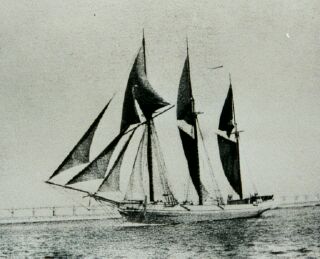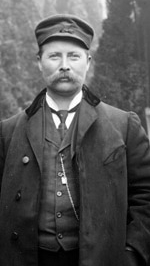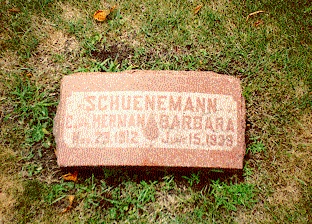|

Rouse
Simmons |
THE CHRISTMAS TREE CAPTAIN
The
following text has been used by permission from the author, Jim Graczyk.
All
pictures and text are protected under copyright law.
Thank
you. Copyright 2004-2017 Jim Graczyk |

Captain
Herman
Schuenemann |
Everyone
at some point in our lives believes in Santa, but for many people from the
Chicagoland area there was an even a more special person they called "Captain Santa." Others called him by a name they knew in which he
provided a service, which was the "Christmas Tree Captain." This
"Captain Santa" was the warm-hearted Herman Schuenemann of the Rouse
Simmons.
At
a certain time of year, Captain Schuenemann would make a yearly voyage from
Michigan's Upper Peninsula to Chicago with a load of freshly cut Christmas trees. Upon making his way into
Chicago
he would tie up along the SW Corner of the
Clark
Street
Bridge
. This was the place he even listed as his business address, the Northern
Michigan Nursery.
The
Northern Michigan Nursery came about at some point in Schuenemann's career after
he gave up buying trees from suppliers and hired his own crew to go into the
woods and cut trees. Schuenemann further eliminated the middleman by selling
trees himself from the deck of his ship instead of to store owners. Time
eventually took its toll and by 1912 the railroads and highways were making
these ships obsolete.
In
1912, he owned 240 acres in upper
Michigan
. Every voyage was a make-or-break adventure. Failure to bring back trees would
leave him penniless, but success meant doubling or tripling his income between
Thanksgiving and Christmas. This years holiday season and weather were going to
be different; since only one storm already had took its toll on Southeastern
Michigan and northern Ohio.
Meanwhile
Captain Schuenemann was realizing he could turn a disaster into profit. The snow
had buried tree farms in
Wisconsin
and
Michigan
.
Chicago
tree merchants were desperate for trees. Captain Schuenemann was happy to
deliver!
At
the Thompson Harbor, Michigan trees were being crammed into every available
space on the Rouse Simmons. It was well into the evening when the Captain
ordered more bundles of trees tied on board the deck, row upon row. The schooner
sagged under the weight of her fragrant cargo. Schuenemann expected this to be
his most profitable year he had ever made.
Despite
stormy weather, the Rouse Simmons set sail at noon on November 22, 1912.
As the Rouse Simmons swung west-southwest heading toward
Chicago
she became engulfed in deadly winds of 60 miles per hour. As fate would have
it, the violent wind had changed suddenly, producing a furious snowstorm and an
incredible drop in temperature. A thick blanket of ice quickly thickened as the
unrelenting waves pounded the ship. Battered hatch covers could no longer
prevent water from entering the hold where it quickly turned into ice on the
trees.
From
the station tower at
Sturgeon Bay
,
Wisconsin
, men sighted the Rouse Simmons flying distress signals as she continued to move
low in the water, driven along by the force of the gale. A rescue team was
dispatched in an attempt intercept the suffering schooner.
Visibility
was difficult and a two hour search proving to be unsuccessful. Just then there
was a break in the snowstorm and the ship sighted. From what men could make of
it, the ship was barely afloat and resembled a floating piece of ice. Rescuers
desperately moved full steam ahead and blinding snow again made it impossible to
see the schooner. The Rouse Simmons vanished from sight and was never seen again,
at least they thought...
The story doesn't end there, sailors have for years reported seeing a
ghostlike Rouse Simmons in the moonlight, sails blowing in tatters, battling
waves in Lake Michigan. One moment the ship is there, then suddenly it fades
away into the darkness.
Eventually
divers found the wreck of the Rouse Simmons in 165 feet of water off the coast
of
Two
Rivers Wisconsin. Some of the historic ship was salvaged for display, which
included the anchor that stands today at the entrance to the Milwaukee Yacht
Club. The schooner's wheel is on display at the
Rogers
Street
Fishing
Village
in
Two Rivers
,
Wisconsin
.
Though
Captain Schuenemann's body was never recovered, his wife is buried in
Acacia
Cemetery
, Section Westaria, 21-4. Strangely
the grave is said to produce the scent of fresh cut spruce and balsam. (
Acacia
Cemetery
is located in Chicago,
7800 W. Irving Park Road
.)

(The
Schuenemann grave)
Ghost
Guides (www.ghostguides.com)
Copyright
2004-2017 Jim Graczyk. All rights reserved.
Contact
Author: Jim Graczyk.


